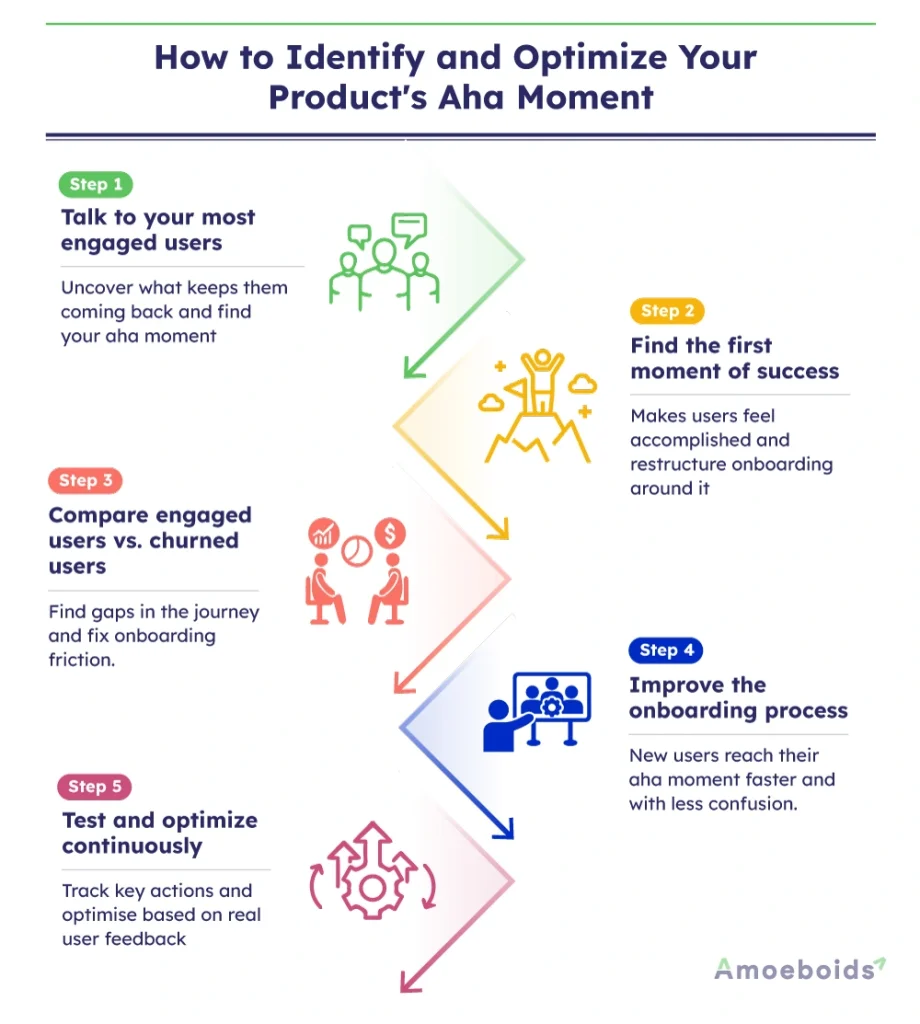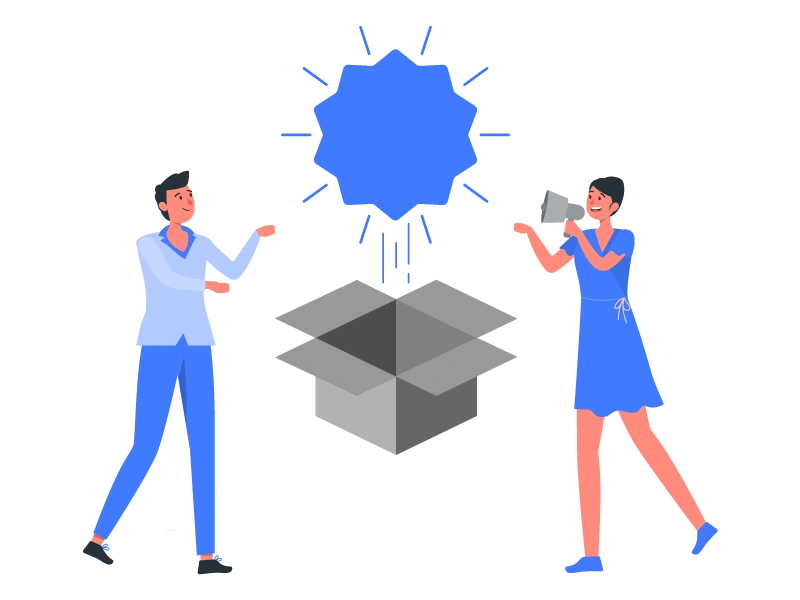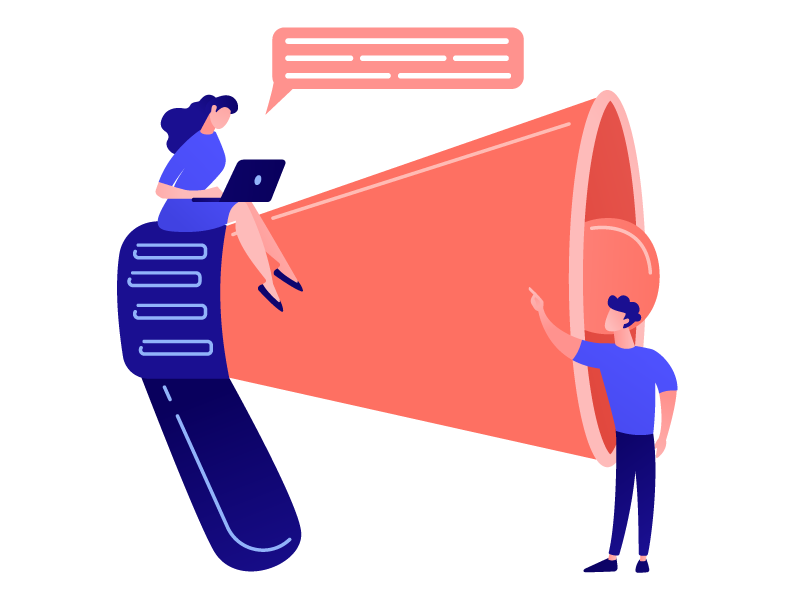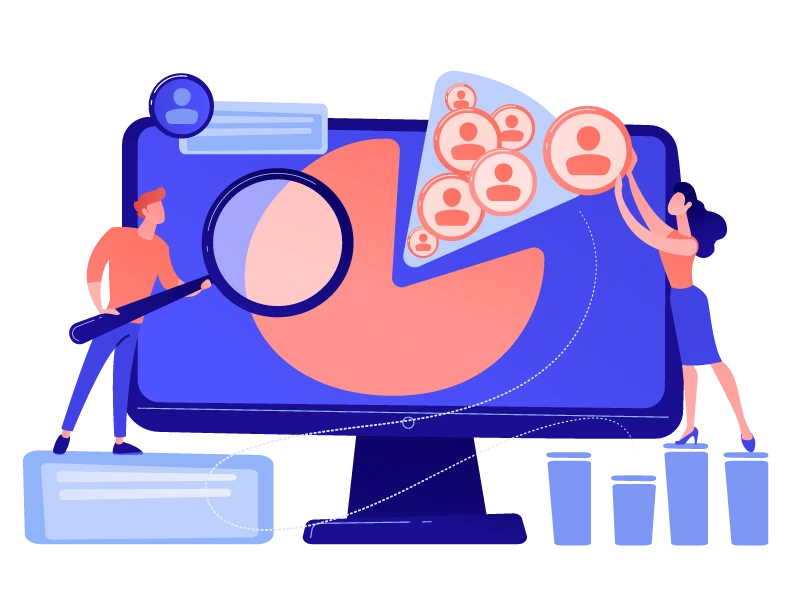Think about the last time you used an app and felt, “Oh wow. This is exactly what I need!” That moment—the instant when everything just clicks—is referred to as the aha moment.
In product management, aha moment is imperative for business growth. But how do you discover what makes your product “click?” What reverse psychology goes into the process of that discovery? Let’s learn the basic steps to find your aha product moment using real business data.
By the end of the article, you’ll have a clear idea of how to create aha moments that boost engagement in your product and keep users coming back.
What is an aha moment?
Imagine you’ve signed up for a new tool and are unsure about it in the initial phase. You then complete a key action—maybe tracking your first task in a project management app or sending your first message in a chat tool. At that precise moment, everything makes sense, and you realize how useful the product is.
That’s an aha moment.
How to get to an aha moment? It’s not just about using the product—it’s about feeling its impact. That moment is what makes a product sell like a hot pie.
Why is aha moment important?
- Users connect with your product emotionally.
- They do repeat business with you (high retention rates).
- You build a loyal customer base (high lifetime value).
Facebook and Grammarly have mastered this concept. Facebook’s aha moment happens when a user adds seven friends within 10 days. This makes the platform more likely to stay engaged.
Similarly, Grammarly’s aha moment occurs when users save time with proofreading without expertise.
The key is to find your product’s aha moment and guide users toward it as quickly as possible. In the next section, we’ll explore how you can do this effectively.
How to find your product’s aha moment?
Every product has a unique aha moment; however, finding it isn’t always easy. It’s not just about guessing what makes users stay. It’s about analyzing real data and understanding user behavior.
Here’s a step-by-step approach on how to get an aha moment for your product:

Step 1: Talk to your most engaged users
Talk to your most engaged users to understand what prompts them to conduct repeat business with you.
How do you find and contact them?
- Look at your analytics and find users who log in regularly.
- Identify those who have been using the product for a long time.
- Check for customers who actively recommend your product.
How to reach out:
Send a simple email asking them for quick product feedback in exchange for a promo code or service discount. If possible, schedule a call for in-depth research.
What to ask during the call:
- What made you start using our product?
- When did you realize it was truly valuable?
- What features do you use the most?
- What features do you never use, and why?
- What would you change or improve?
Action step: After gathering responses, look for common themes. What moment did most engaged users mention as their turning point? That’s your aha moment.
Step 2: Find the first moment of success
Identifying key user actions is one way to find the aha moment, but another powerful approach is to look at when users first succeed with your product.
Instead of just tracking engagement, you need to ask:
When do users feel like they have accomplished something meaningful?
1. Look at when users first see results:
- If you have a design tool, do they complete their first project?
- If you have a finance app, do they successfully submit an expense report?
- If you have a fitness app, do they log their first workout?
2. Check customer feedback:
- What moment do customers mention in reviews and testimonials?
- What positive experiences do they share on social media?
3. Ask new users directly:
Instead of waiting for churned users, ask first-time users: “At what moment did you feel that [product] was useful to you?”
Action step: Identify the first success milestone that makes users feel like they’ve achieved something valuable. Then, restructure onboarding so that new users reach this milestone as soon as possible.
Step 3: Compare engaged users vs. churned users
If some users stay and others leave, the difference lies in their experience with your product. Understanding why churned users didn’t reach their aha moment will help you fix onboarding issues and improve retention.
To start with, identify users who signed up but never returned. You need to find out why they left before they experienced the real value of your product. Feel free to reach out to them via email.
Once you receive responses, compare them with engaged users’ feedback. You might notice a common issue—perhaps the onboarding process was unclear, or users weren’t sure how to get started. This will highlight a gap in your user journey.
Now, you know where the friction is. The next step is to fix these issues so that new users reach the key action without confusion or frustration.
Step 4: Improve the onboarding process
Once you’ve found your aha product moment, the next step is to help new users reach it as quickly as possible.
How to improve onboarding:
- Simplify the signup process—remove unnecessary steps.
- Use in-app guidance (tooltips, pop-ups, walkthroughs) to lead users to the key action.
- Send reminder emails nudging users toward their aha moment.
What to focus on:
- Show the value upfront—don’t make users dig for it.
- Make the first key action easy to complete.
- Remove distractions that don’t contribute to the aha moment.
Action step: Test your onboarding by guiding new users toward the key action within their first session.
Step 5: Test and optimize continuously
Your product’s aha moment might change as your audience grows; therefore, keep testing what works.
How to optimize:
- A/B test different onboarding methods and track conversion rates.
- Monitor engagement metrics to understand where users drop off.
- Regularly update your onboarding flow based on user feedback.
Key metrics to track:
- Retention rate after the first session.
- Time taken to reach the aha moment.
- Completion rate of the key action.
Action step: Keep refining your process until most users hit their aha moment quickly and consistently.
Next, we will see how big brands such as Slack and Canva maintain their aha moments to dominate the market competition.
Five product aha moment examples
Here are some product management aha strategies of five popular brands for inspiration.
1. Slack: Sending 2,000 messages in a workspace
Slack is a business communication tool that helps teams collaborate efficiently. It integrates with numerous apps and provides channels, direct messaging, and automation for seamless communication.
Aha moment
Slack’s aha moment happens when a team collectively sends 2,000 messages in a workspace. At this point, users realize how Slack reduces the need for email and speeds up communication.
How it guides users to aha moment:
- Interactive walkthrough: Slack provides a hands-on onboarding experience that guides users through sending their first message and setting up channels.
- Bot assistance: Slackbot offers real-time prompts to help users explore commands, integrations, and workflows.
- Encouraging team adoption: Slack ensures that team members invite others, making the product even more useful as engagement grows.
Why it works: By encouraging active participation, Slack ensures users quickly discover the impact of instant communication without friction.
2. Canva: Creating the first professional design
Canva, a graphic design platform, allows users—regardless of experience—to create visually appealing content for social media, presentations, and marketing materials.
Aha moment:
Canva’s aha moment happens when a user, even with no design experience, successfully creates a professional-looking design within minutes.
How it guides users to aha moment:
- Personalized onboarding: New users answer a short survey to receive design templates relevant to their needs.
- Drag-and-drop simplicity: The intuitive editor makes it easy for beginners to customize templates with text, colors, and images.
- AI-powered suggestions: Canva recommends design elements based on user activity, helping them improve visuals quickly.
Why it works: Canva removes the intimidation factor of graphic design by making it easy, fast, and rewarding.
3. Zoom: Hosting the first successful video meeting
Zoom is a video conferencing platform used for virtual meetings, webinars, and online events across the world.
Aha moment:
Zoom’s aha moment occurs when a user hosts their first successful video meeting without technical issues.
How it guides users to aha moment:
- One-click meeting setup: Zoom minimizes friction with easy sign-up and instant meeting links
- Pre-meeting testing: Users are encouraged to test audio, video, and background settings before starting a real meeting.
- Intuitive UI: Features such as screen sharing and breakout rooms are displayed with tooltips, helping users explore without confusion.
Why it works: Zoom removes barriers to communication by making video meetings effortless, even for first-time users.
4. Mailchimp: Sending the first email campaign
Mailchimp, an email marketing platform, helps businesses create, send, and analyze marketing emails.
Aha moment:
Mailchimp’s aha moment happens when users successfully send their first email campaign and see the results.
How it guides users to aha moment:
- Step-by-step email builder: Mailchimp’s email editor provides real-time previews and easy drag-and-drop features to help users create their first email.
- AI-powered content suggestions: The platform recommends subject lines, images, and content tweaks to improve email engagement.
- Personalized templates: Users get customized email templates based on their industry and goals, making the process faster.
Why it works: By focusing on simplicity and quick wins, Mailchimp reduces the effort required to launch an email campaign.
5. Calendly: Connecting a calendar and booking the first meeting
Calendly is a scheduling tool used by professionals and teams to book, prepare for, and follow up on meetings with ease.
Aha moment:
Calendly’s aha moment happens when a user connects their Google Calendar and schedules their first meeting. This eliminates the back-and-forth hassle of coordinating availability.
How it guides users to aha moment:
- Google Calendar integration: As soon as users sign up, Calendly nudges them to sync their calendar, making the process seamless.
- Guided practice booking: Users are given the option to book a test meeting with themselves, reducing anxiety about using the tool.
- Smart availability suggestions: Calendly automatically detects free slots and suggests them to attendees, saving time.
Why it works: By making scheduling instant and stress-free, Calendly removes a common workplace frustration, ensuring users see its value immediately.
Conclusion
Every product has its own ‘aha moment’—the instant users realize its real value. But finding it isn’t easy. It requires more than guesswork; it requires analyzing real data and understanding user behavior.
Talk to your most engaged users to uncover your product’s aha moment. Compare their experiences with those of churned users. Identify the first milestone where users feel they’ve achieved something meaningful. Then, optimize your onboarding process to help new users reach this milestone faster.
Keep refining your approach using mental models for Product Managers until most users consistently hit that aha moment early in their journey. The faster they do, the more likely they are to stick around.



